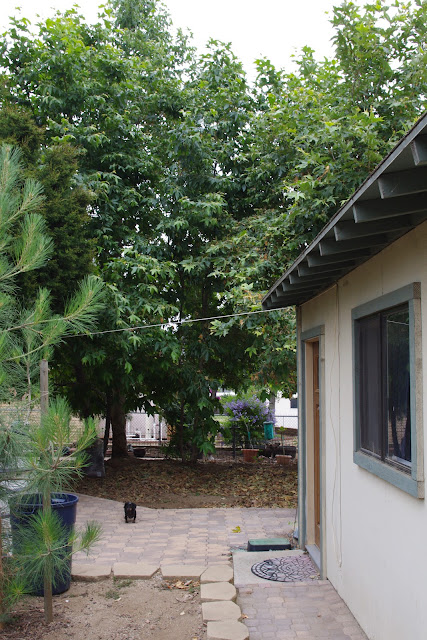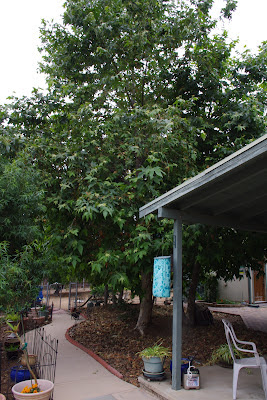Is the Plant in the Right Exposure, eg. Sun or Shade?
Now take a look at those picturesque cool & green looking paradisaic garden scenes. Who wouldn't want such a Paradisaic settings in their backyard ? Unfortunately if you reside in dry hot regions of the southwestern United States you may have to rethink your gardening plan. You do you ? Well, rethink in terms of planning and strategy. The city of San Diego CA has a mild mediterranean climate and you can growth just about anything that grows anywhere else on the planet, with a few rare exceptions. Travel further inland from the coastal areas of San Diego and it's a different story. The climate is much hotter and drier in summer and such settings as pictured above may take awhile. This is if you have the patience to create a microclimate setting. In the case of the Woodland Garden Theme, you'll have to plant some of those pioneer species we wrote about early. In this case in the form of a healthy tree cover canopy. Every plant has specific watering, fertility, sun/shade requirements that may differ from other plants. This is true of even native herbaceous and shade loving plants that you see on the forest floor of those pics above. Truly, in other localities where they can get away with open environment planting, So-Cal Gardeners will have to create a micro-climate. You should know all those requirements of any plants you purchase from the Nursery. Your local area Nurseryman should be helpful in the info department. Here's a pic below that beautifully illustrates just what takes place in nature where plant succession is normal and necessary. None of those delicate plants will appear in direct sunlight at the beginning. It may even take several decades. However, in a gardening situation there are things we can do to speed things up.

I actually did this at my mother's place in El Cajon just before I left in 2006. Before creating a cool forest floor scene, you first need to architect a design which may take a few years to accomplish. Like anyone else, I have that same impatient human desire for instant landscape. And I want it yesterday! Unfortunately urban landscape life or even life in the real wild world doesn't exactly work that way. So you need to create a woodland tree shaded canopy before those soft delicate plants can be installed where you want them.Now again, I'm as impatient and excited as much as the next person, but for me I personally like to choose plants that are in one gallon pots. I know the temptation is to get a Five Gallon Container or even a large Box Tree if you can afford it, but I plead with you, please resist that temptation!

That is pretty much the size I planted in my mother's backyard. They were all no more than six inches tall. No seriously, they were! What I did was create two large curved raised planted beds. What I did was plant them in groupings of three to a bed spaced five foot apart. I wanted to replicate what you see in nature where California Sycamores can often be seen growing in groups of several individuals or at least the same older trees are actually multi-trunk as a result of some suckering from decades previous. Even some storm damage event may have caused this picturesque scene, but nevertheless, that was the design I wanted. So Six, six inch high one gallon Sycamore Trees were planted in groups of three at 4 or 5 foot apart from each other. Here is what they looked like in the Spring of 2011 at five years of age.
 |
| photo: Mine |

Now at this point she can choose whatever shade loving delicate plants like Ferns, Coral Bells, Wild Current, etc to her heart's delight. But at least now the choices are much greater than before.I'm not sure, but I believe these pics were taken just after I thinned out and trimmed all of the trees for any dead wood and excessive branch growth where it came close to the ground. But you can see the growth was rapid and without much watering I might add, because the sandy loam soil is several meters deep. To the left of that top pic which shows a little weiner dog and the branches of a Torrey Pine (Pinus torreyana) there are also four tall slender Canary Island Pines (Pinus canariensis) which I referenced in an previous blog post on my disappointment with my Tecate Cypress [Cupressus forbesii] woodland garden experiment. The pines volunteered from the pines mulch can chippings from a job done where I worked. So I let them take the place of the wind blown Cypress trees. In that same upper pic you'll notice the Tecate Cypress in the background of the Torrey Pine to the left side of the picture. Here's also a picture of those Canary island Pines and keep in mind they are the same 5 years of age as those California Sycamores.

On the underside there of that center Pine you'll see a Catalina Currant (Ribes viburnifolium) which works well in the shade. In fact there it is a must or it becomes burnt from the sun. On the opposite side or behind those trees I also planted at the time I planted the Tecate Cypress, I also planted a one gallon native California Spice Bush (Calycanthus occidentalis) which was really planted too early as it definitely needs the shade there in that locale. It's huge and happy now, but for some years it sunburned real easy in the exposure. Back to the Sun/Shade and other environmental choices dilemma, the exact opposite will be true of other ecosystem environments you may want to try and replicate in your urban landscape. Here's a pic of that Spice Bush which definitely adds a good background beauty under any tree canopy. Keep in mind if it really becomes happy in it's location, you will have to deal with pruning it once a year to maintain the desired size for the landscape.

There are certainly more ideas, but hopefully my personal experience gives folks from different areas ideas that they can pursue if they have knowledge of plant requirements for their area. Keep in mind also, that as true to the theme of this particular blog, everything you see was installed with various mycorrhizal treatments and ALL of the trees and shrubs are only fed with generous helpings of healthy mulch and compost. None have ever been fed commercial chemical fertilizers. The other side benefit has been a big fat ZERO in the pest problem department. When you have a healthy networked underground grid system, the potential pest simply don't enjoy these connected plants as much as the chemically fed ones. It doesn't mean that the pests are not around anywhere. No doubt they are, but in small numbers that are easily managed by all the other biological controlling agents. In my next post I'll show how I architect a system to attract beneficial wildlife to make gardens pest safer.
Best Wishes on your future gardening project's next installation of it's own "Earth Internet" operating system!




No comments:
Post a Comment
Thanks for visiting and stopping by with your comments!
I will try to respond to each comment within a few days, though sometimes I take longer if I'm too busy which appears to be increasing.